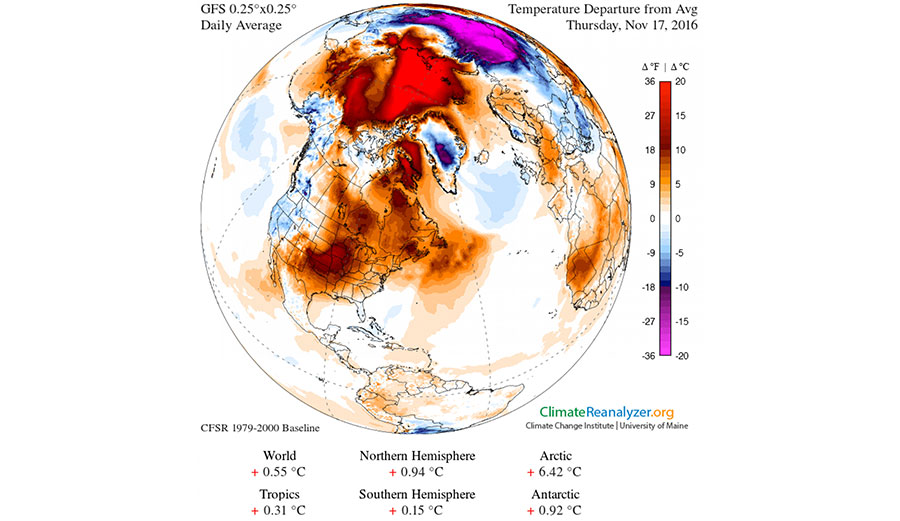
See that big red spot above the Arctic? That’s not supposed to be there. Image obtained using a climate reanalyzer. Image: (Climate Change Institute/University of Maine)
Each winter, something very important to the rest of the planet happens in the Arctic. It’s called polar night, and as the name suggests, the sun doesn’t come up on most of the Arctic. It’s so important because that’s when things get really, really cold there and the sea ice that plays such an important role in everything from global temperature to the weather gets thicker and larger. Then, in the summer, it reflects heat from the sun and helps cool the entire planet. But this year, something is very, very off. It’s not just a few degrees warmer than it should be–it’s an astonishing 36º F hotter than usual.
“It’s about 20C warmer than normal over most of the Arctic Ocean, along with cold anomalies of about the same magnitude over north-central Asia,” Jennifer Francis, an Arctic specialist at Rutgers University, told The Washington Post.
Climate-wise, 2016 has been a pretty strange year. Nearly every month has broken a record for something bad–high temperatures, ice levels, etc.–and it’s wreaking havoc on the rest of the world. While the Arctic is turning into a tropical paradise (relative to normal, at least), Siberia is experiencing way colder temperatures than usual. It seems that the cold polar air that normally swirls around the Arctic has been displaced and found a new home over Siberia.
It’s not just the air that’s warmer, either. Water temperatures are skyrocketing, too. “There are some areas in the Arctic Ocean that are as much as 25 degrees Fahrenheit above average now,” said Mark Serreze, Director of the National Snow and Ice Data Center. “It’s pretty crazy.”
According the National Snow and Ice Data Center, “both the thickness and extent of summer sea ice in the Arctic have shown a dramatic decline over the past thirty years. This is consistent with observations of a warming Arctic. The loss of sea ice also has the potential to accelerate global warming trends and to change climate patterns.”
Although climate change deniers (and to be clear, no one’s saying climate change isn’t a natural phenomenon, they’re just saying we’re accelerating it at a very alarming rate) will tell you that it doesn’t matter that the Arctic sea ice is shrinking because the Antarctic sea ice is growing, it really, really DOES matter. Antarctica doesn’t play the same role in global weather patterns at the Arctic. “Antarctica is a continent surrounded by water, while the Arctic is an ocean surrounded by land,” NSIDC explained. “Wind and ocean currents around Antarctica isolate the continent from global weather patterns, keeping it cold. In contrast, the Arctic Ocean is intimately linked with the climate systems around it, making it more sensitive to changes in climate.”
Last year, in fact, was similar to this year. Around Christmas of 2015, a huge storm swirling around the Arctic funneled strangely warm air into the area and brought temperatures above freezing. Researchers are stunned by the newest weather data. “Despite onset of #PolarNight, temperatures near #NorthPole increasing. Extraordinary situation right now in #Arctic, w/record low #seaice,” wrote a climate scientist at UCLA.
The temperature is skyrocketing, and everyone (except the new head of the EPA, of course) agrees that it’s not going to stop any time soon. “The Arctic warmth is the result of a combination of record-low sea-ice extent for this time of year, probably very thin ice, and plenty of warm/moist air from lower latitudes being driven northward by a very wavy jet stream,” wrote Jennifer Francis, who specializes in Arctic weather patterns at Rutgers University. “It will be fascinating to see if the stratospheric polar vortex continues to be as weak as it is now, which favors a negative Arctic Oscillation and probably a cold mid/late winter to continue over central and eastern Asia and eastern North America. The extreme behavior of the Arctic in 2016 seems to be in no hurry to quit.”
So what does this all mean for the future? Well, more of the same, really: bigger storms, bigger temperature swings, and an increasingly dangerous planet.

